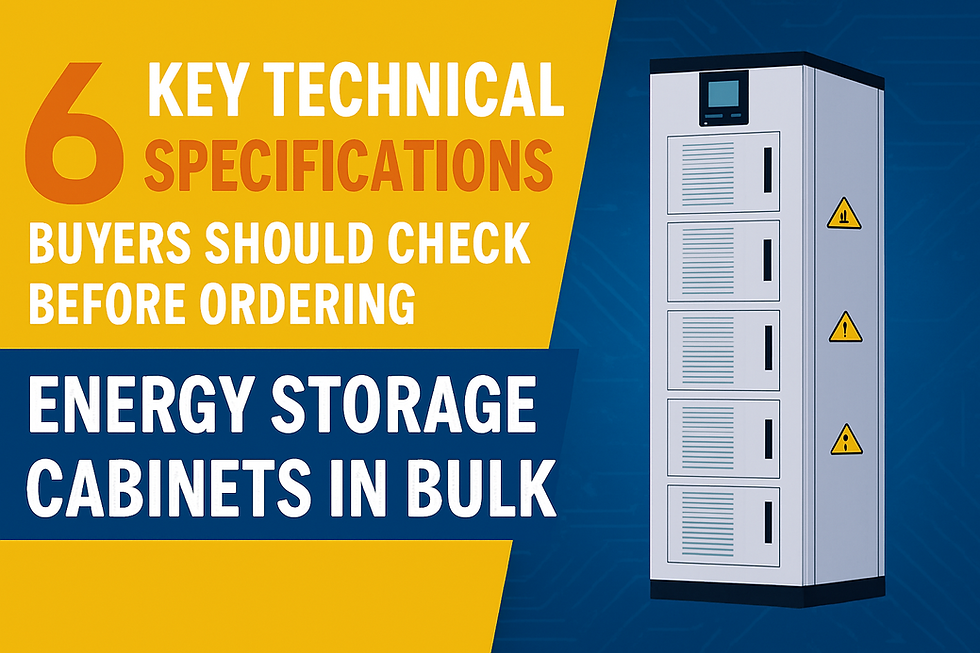Clean Your Energy Storage Cabinet: A Professional Guide
- bzpowereq
- Feb 26
- 3 min read

Keeping your energy storage cabinet interior clean is essential for maintaining the efficiency, longevity, and safety of your energy storage system. Dust, dirt, and environmental contaminants can reduce system performance and lead to potential failures. This guide will walk you through the best practices for cleaning your energy storage cabinet safely and effectively.
Why Cleaning the Energy Storage Cabinet Interior Is Important
Regular cleaning of your energy storage cabinet helps:
🔹 Ensure optimal performance by preventing dust accumulation on components.
🔹 Prevent overheating by maintaining proper airflow and ventilation.
🔹 Reduce risk of electrical faults caused by moisture or debris buildup.
🔹 Increase lifespan of batteries and electronic components.
Tools and Materials You’ll Need
Before starting, gather the following cleaning supplies:
✔️ Anti-static cloth (to prevent static electricity damage)
✔️ Vacuum with ESD (Electrostatic Discharge) filter
✔️ Isopropyl alcohol (70% or higher)
✔️ Soft-bristled brush (for delicate components)
✔️ Compressed air canister (to remove dust from tight spaces)
✔️ Rubber gloves & safety goggles
✔️ Multimeter (to check voltage levels before cleaning)
Step-by-Step Guide to Cleaning an Energy Storage Cabinet Interior
Step 1: Power Down the System Safely
✔️ Shut down the energy storage system according to manufacturer guidelines.
✔️ Disconnect the power source and ensure there is no residual charge in the system.
✔️ Use a multimeter to verify that no voltage is present before proceeding.
Step 2: Remove External Dust and Debris
✔️ Use a dry, anti-static cloth to wipe down the exterior of the cabinet.
✔️ If there’s excessive dust buildup, use a vacuum with an ESD-safe filter to clean vent openings.
Step 3: Open the Cabinet and Inspect Components
✔️ Open the storage cabinet using the appropriate tools (check the manufacturer’s guidelines).
✔️ Visually inspect for dust accumulation, loose connections, or signs of corrosion.
✔️ Check ventilation fans and air filters for blockage.
Step 4: Clean Interior Surfaces
✔️ Use a soft-bristled brush to remove dust from delicate circuit boards and battery terminals.
✔️ Wipe down non-electrical components with a slightly damp anti-static cloth.
✔️ For stubborn dirt, apply isopropyl alcohol to a cloth and carefully wipe down surfaces.
Step 5: Clean Battery Terminals and Connections
✔️ If you notice any corrosion on battery terminals, use a mixture of baking soda and water to neutralize it.
✔️ Use a dry, soft brush to remove corrosion and follow up with isopropyl alcohol for residue removal.
✔️ Ensure all connections are dry before reconnecting power.
Step 6: Use Compressed Air for Tight Spaces
✔️ Blow out dust from hard-to-reach areas using short bursts of compressed air.
✔️ Hold the can upright and avoid tilting to prevent moisture release.
Step 7: Reassemble and Test the System
✔️ Once the cabinet is clean and dry, securely close it.
✔️ Reconnect the power and run a system diagnostic check to ensure proper operation.
Safety Tips When Cleaning an Energy Storage Cabinet
⚠️ Never use water-based cleaners on electrical components.
⚠️ Avoid using metal tools near live components to prevent short circuits.
⚠️ Ensure proper ventilation when using isopropyl alcohol.
⚠️ Follow manufacturer guidelines for cleaning and maintenance.
⚠️ Dispose of any cleaning materials that come in contact with battery residue safely.
How Often Should You Clean an Energy Storage Cabinet?
✔️ Monthly: Quick dust removal from exterior vents and fans.
✔️ Quarterly: Light interior cleaning of cabinet surfaces and components.
✔️ Annually: Deep cleaning with component inspection and corrosion checks.
Final Thoughts
Regular maintenance of your energy storage cabinet interior ensures optimal performance, safety, and longevity of your energy storage system. By following this guide, you can prevent system failures, reduce overheating risks, and extend the lifespan of critical components.




Comments